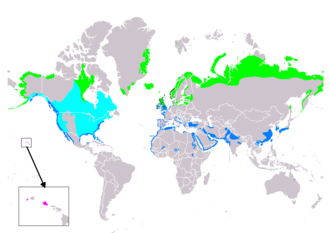I had a first sighting of a dunlin at the Leonabelle Turnbull Birding Center in Port Aransas, Texas, on Thanksgiving day 2021 which confirmed that I have a very difficult time trying to identify small shore birds and distinguish them from one another. I didn't know I'd seen a new first (a new species of bird to me), thinking it was a sandpiper, until I submitted a photo to iNaturalist and the website suggested it was a dunlin.
The dunlin is a stint, which the Wikipedia article notes are "difficult to identify because of the similarity between species [such as the western sandpiper and least sandpiper], and various breeding, non-breeding, juvenile, and molting plumages" as well as some plovers that are "similarly patterned, especially in winter."
 |
| Light green is breeding, dark-blue is non-breeding and light-blue is migrating. From Wikipedia. |
There are ten subspecies of dunlin that breed in the Arctic and sub-Arctic, including Russia, northern Finland and northern Sweden, much of Norway, Iceland, eastern and southern Greenland, northern and western Alaska, including the Aleutian Islands, and portions of northern Canada. Calidris alpina pacifica breeds in western Alaska, C. a. articola breeds from northwestern Alaska to northwestern Canada and C. a. hudsonia breeds in the area of the western Hudson Bay and north. They winter primarily along the coast. in North America, that includes the Pacific coast from Alaska to central Mexico, the Gulf Coast (where I saw them) and the Atlantic Coast up into New England.
Non-breeding birds, like I saw, are basically white underneath and brownish/gray above and have a long, drooping, black bill. Breeding birds have a black belly and a rusty, mottled back.



I'm glad you have iNaturalist for a birding friend.
ReplyDelete